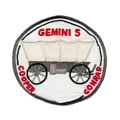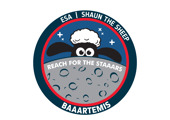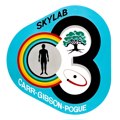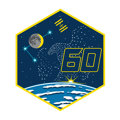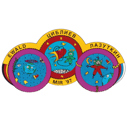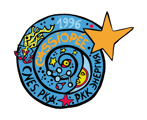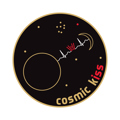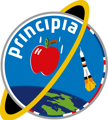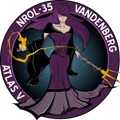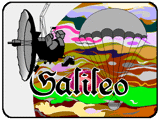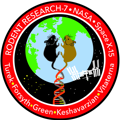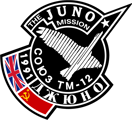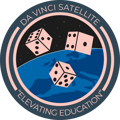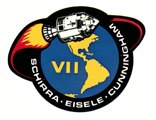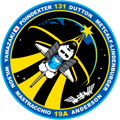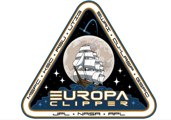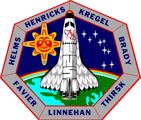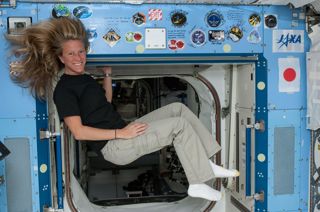
My Top 5 Mission Patches of All Time
- 19th Jun 2025
- Author: Chloe Hopkinson
When it comes to space exploration, it's not just the rockets, robots, and astronauts that make history – it is also the mission patches, and no space adventure is complete without the stylish accessory. Mission patches have become an iconic symbol of humanity’s space ventures and are quite a tradition, each one unique and quirky to reveal a creative snapshot of a moment in space history.
In this blog, I will delve into five of my favourite mission patches, which was quite a mission in itself with 100s to choose from! It is unavoidable, so pre-warning: you will read the words ‘mission’ and ‘patch’ a bunch of times!
So, how do mission patches manage to stand out and remain unique from every design that came before them? It is the astronauts themselves who design the patches, and it is pretty much a rite of passage for every crew these days, although the commander of each mission does get final say on how it looks.
The teams and crews carefully consider the shape, colours, imagery, symbols, wording, and finer details to create a design that truly captures the spirit and objectives of their mission. However, it is not just crewed missions that are celebrated through woven badges – uncrewed flights, satellites, telescopes, and Solar System exploring probes are usually in receipt of their own distinctive insignia too.
Before we jump into the round-up, let’s investigate the origins of mission patches and discover why they've become such iconic and cherished symbols in the realm of space exploration.
-
![Valentina Tereshkova Vostok-6]()
Spacepatches.nl Vostok 6
This badge is the first known use of space patch and was worn by Valentina Tereshkova, the first woman in space, for the Soviet Vostok 6 mission in 1963.
The patch consisted of a white dove carrying an olive branch, standing atop the letters CCCP (the abbreviation of the Soviet Union) and was adorned on her shoulder – though it was not visible during her flight as it was hidden beneath her spacesuit. The white bird is considered to be a nod to her call sign as ‘Seagull’, or ‘Chayka’ in Russian.
-
![Gemini 5]()
NASA / Public Domain Gemini 5
NASA began introducing mission patches a couple of years later in 1965 for the Gemini 5 mission. This mission patch was designed by Gordon Cooper and Pete Conrad and features a Conestoga wagon to capture the pioneering spirit of their journey, where the aim was to complete a record-setting 8 days in space. This also explains the slogan ‘8 Days or Bust’ across the wagon, which was ordered to be covered by a thin layer of cloth and only revealed upon the success of the mission.
Whilst Cooper and Conrad’s names are embroidered, they expressed that it represented everyone working on the programme, something that was worth mentioning to James Webb, the NASA administrator at the time, in order to convince Webb to let them wear the patch for the flight.
-
![Apollo 11 woven patch]()
NASA / Public Domain Apollo 11
You were probably expecting to see this one, and there’s no way I could write a blog about mission patches and not include one of the most iconic of the bunch – Apollo 11. The crew decided early on that they did not want their names on the patch as they wanted it to be representative of everyone’s contributions to land humans on the Moon. Michael Collins, the Apollo 11 Command Module Pilot, took the main lead for designing the patch.
A bald eagle with its feet extended and its wings partially folded as if it was coming into land would represent the American achievement. An olive branch was added, but not to the beak where the bird would usually carry a branch, but into the grips of its talons – this was decided to avoid the eagle looking hostile and menacing as it comes into land. Earth was added to the background but the shadow across the planet shows light from the Sun coming in from the wrong direction – the shadow should instead creep up from the bottom of the Earth.
Now, in no particular order, let’s explore my personal top five mission patches!
VAKO Soyuz
This patch is of the All-Russian Youth Aerospace Society, or VAKO, from 1988 and is a group for children who have a keen interest in aviation and aeronautics. The VAKO logo features a young cosmonaut riding on the back of a bear, where the bear represents the constellation of Ursa Major. If you look closely, you will notice the stars inside the bear make up the shape of The Plough, or The Big Dipper, which is an asterism, meaning it is part of the constellation of Ursa Major. Swooping around the back of the cosmonaut’s head is a fighter jet, which symbolises the aeronautical aspect of the society.
The patch was taken into space by VAKO’s president, cosmonaut Alexander Serebrov, and was worn during one of his spacewalks outside the Mir space station in 1993. A silver doll named Vakosha was also decorated with the patch and was taken to space in 1994.
Shenzhou-5
This mission patch is from Shenzhou 5, which launched on 15 October 2003. It was the first human spaceflight mission from the Chinese space programme and launched Yan Liwei up into orbit around the Earth.
The patch features a white, floating figure which depicts Chang’e, a mythical Moon goddess from Chinese folklore and represents China’s ambition of landing on the Moon, which spoiler alert, they landed their first uncrewed spacecraft there with their Chang’e 3 lander in 2013. The Chinese characters ‘神舟’ translates to ‘Shenzhou’ and means ‘Divine Vessel’, highlighting this national milestone.
In May 2023, Chinese space officials announced their intention of landing astronauts on the Moon by 2030 - something that has been decades in the making.
Spirit and Opportunity
In 2003, two familiar characters became the face of the twin Mars rovers Spirit and Opportunity. Those faces belong to Marvin the Martian and Daffy Duck as the fearless Duck Dodgers, with both being dubbed the Red Planet Gladiators. These individuals were selected for their fun and adventurous nature, as well as their animated lives being full of space adventure – Marvin of course being a Martian himself!
Whilst these patches were not used in official mission branding or even worn by the robots as they of course don’t have spacesuits to stitch them to, the patches instead decorated the jackets of the crews and teams associated with the missions, as well as being displayed in the mission control booth and at the launch pad site.
Marvin the Martian was chosen to represent the Spirit rover which landed on Mars on 4 January 2004. Marvin stands proudly in front of the US flag and salutes a visual of the Delta II rocket that the spacecraft launched on. Marvin highlights the idea of reaching Mars as science fiction dreams that come true! Duck Dodgers, the sci-fi alter ego of Daffy Duck, was designated to the Opportunity rover, which landed on Mars three weeks after its twin, on 25 January 2004.
Soyuz TMA-01M
This patch belongs to the Soyuz TMA-01M mission that launched on 7 October 2010, carrying three astronauts to the International Space Station on Expedition 25.
The patch bears their surnames alongside the US flag and the Russian flag, as well as the three stars to represent each member of the crew. The nine rays of the sunrise are representative for each member of Expedition 25 and 26. The stylised Soyuz spacecraft is made up of the binary numbers 0 and 1, and translates into ‘STMA-01M’ – the mission’s name. It also reflects the major technological upgrade in Soyuz spacecraft as this was the first flight of the modernised, digital version of Soyuz.
The binary spacecraft is accompanied by the outline of a crane which is based on artwork provided by 12-year-old Alexander Turovsky of Michurinsk, Russia (which was part of a children’s competition), and from a photo of a crane captured by Tom Wallace from Illinois.
Together, the Soyuz and the crane form an ‘X’ shape to signify this first flight of a new type of Soyuz spacecraft, which is further emphasised by the hexagonal technical shape and orange border of the patch.
NROL-39
The final patch belongs to USA-247, also known as NROL-39, and belongs to a reconnaissance satellite launched by the US in December 2013. I may be biased with this one as octopuses are my favourite animal!
The huge yellow creature wraps its tentacles around the Earth, specifically clutching North America in its beak. The octopus was chosen as they are highly intelligent, remarkably adaptable, and incredibly versatile creatures, and the motto ‘Nothing is Beyond Our Reach’ serves as a reminder of Earth observation and monitoring.
Whilst the octopus looks menacing as it grasps the planet, the use of the sea creature originates from an in-joke with the engineering crew who battled with a piece of cabling called an ‘octopus harness’ and it caused issues for the satellite during testing, resulting in the team exclaiming that ‘the octopus harness had taken over the world’.
From mythological moon goddesses and cartoon characters from children’s creations, to curious creatures from the air to the sea, mission patches do far more than just look cool – they capture the essence, spirit, and culture of the teams behind them. Whether they’re worn proudly on a spacesuit or tucked into a console at mission control, these embroidered emblems become lasting symbols of humanity’s reach into the stars, full of storytelling, symbolism, and often a good dose of humour.
So, the next time you see a mission patch, take a moment to look closely – you might just find a hidden comet, a child’s sketch, or a nod to a spacefaring duck. Each one is a stitched snapshot of space history.
Full Credits / References:
(Banner image) Karen Nyberg on the ISS with signed sticker patches, Credit: NASA / JSC / Public Domain
(Carousel of 3 images) Muninn mission patch first sketches; Muninn mission patch explained; Final design of Muninn mission patch, Credits: ESA / K. Lochtenberg
(1) Valentina Tereshkova mission patch, Credit: Spacepatches.nl (http://www.spacepatches.nl/index.html)
(2) Gemini 5 mission patch, Credit: NASA / Public Domain
(3) Apollo 11 mission patch, Credit: NASA / Public Domain
(4) VAKO Soyuz, Credit: Spacepatches.nl (http://www.spacepatches.nl/index.html)
(5) Shenzhou-5, Credit: Spacepatches.nl (http://www.spacepatches.nl/index.html)
(6) Spirit and Opportunity mission patches, Credit: United States Air Force and Warner Brothers™
(7) Soyuz TMA-01M mission patch, Credit: Spacepatches.nl (http://www.spacepatches.nl/index.html)
(8) NROL-39 mission patch, Credit: Public Domain
(Carousel of mission patches) Various, Credits: NASA, ESA, CNES, DLR, Public Domain












